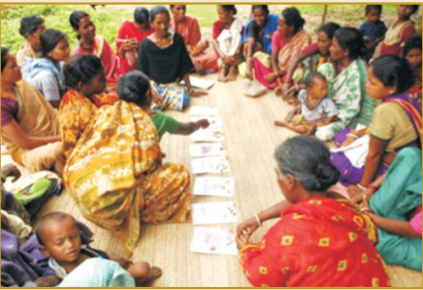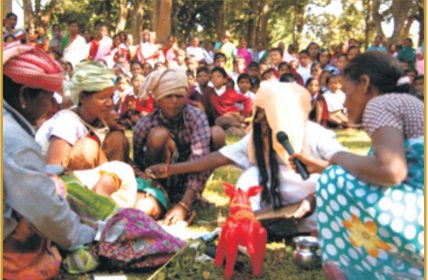Participatory Learning and Action cycle with women’s groups
Participatory Learning and Action cycle with women’s groups
Introduction
A Participatory Learning and Action cycle with women’s groups to improve maternal and new- born health outcomes is the project executed in West Singhbhum and Sarikela Kharsawan districts of Jharkhand and Keonjhar district in Odisha.
The different stakeholders' groups were SHG groups, other women groups, ASHA workers, ANMs, AWWs, Village Health Committee, Traditional Birth Attendants, Pregnant mothers, Lactating mothers, etc.
Activities
Neo natal care and maternal health are the major intervention activities wherein a participatory learning and action cycle with 244 women's groups was implemented in 18 intervention clusters covering an estimated population of 1,14,141. The participatory groups met on a monthly basis, guided by a facilitator, throughout the three-year study period. They used a participatory learning and action cycle, in which maternal and new-born health problems were identified and prioritised. Strategies to address these problems were developed, implemented and evaluated with the support of the entire community.
Thus, the approach is a mix of didactic, interactive and participatory methods, demystifying technical subjects, so that the community members can also understand them. The methodology is based on adult learning processes that help internalisation and critical thinking. It helps in developing problem solving skills in the community to find feasible solutions at local level. Along with it, the peer support and the pathway of diffusion of learning within the community enhances herd effect and helps in better adoption of the altered behaviour. Moreover, being facilitated by local people, and employing locally relevant contexts helps community to identify with the problem and search for solutions.
In the Participatory Learning and Action cycle, the PLA meetings are phased out and spread over sufficient time period to allow the community time to reflect, discuss and think through the issues.
Participatory Learning and Action Meetings
To address underlying causes of malnutrition, monthly PLA meetings are conducted with women’s groups to address issues like early marriages, birth spacing, nutrition in pregnancy and water and sanitation. The meetings aim to catalyse individual and community action for maternal and child health and nutrition.
Home Visits
A single home visit to each pregnant woman in the third trimester of pregnancy with counselling on maternal nutrition, followed by monthly home visits to all children under two, with counselling for growth promotion is taken up. At each visit to a mother and child, information is collected about current or recent illness, mid-upper arm circumference (MUAC) measurement for children over 6 months and then the mother is engaged in a dialogue about feeding, infection control and care giving practices. Home visits address the immediate causes of malnutrition. A Suposhan Karyakarta visits home of every pregnant and lactating mother in the project area and counsels her on infant feeding practices, protection of young children from infections, appropriate child caring practices and proper dietary intake of mothers, etc.
Surveillance
Mothers and their children are followed up at seven time points under the surveillance system:
- During the third trimester of pregnancy
- Within 72 hours of birth
- At 3, 6, 9, 12 and 18 months
Anthropometry data on mother and children’s nutritional status is also being collected through a mobile-based data collection and digital data management platform.
Strengthening Village Health Sanitation and Nutrition Committees (VHSNCs):
Village Health and Nutrition Committees are being trained on health and nutrition of mothers and children. Quarterly participatory meetings with VHSNCs which involves participatory discussions to sensitise members to issues related to inequity and exclusion from health and nutrition services and entitlements, as well as identifying and addressing gaps in health and nutrition services.
Impact
The benefits of the intervention to the stakeholders are multiple. The fairly simple home-care practices discussed in the women’s group meetings in the Ekjut trial probably addressed important causes of death among groups with high rates of neonatal mortality. Neonatal death often results from a combination of and interaction between morbidities. Therefore, the spin-off effects of addressing one risk factor on other risk factors are arguably greater among the more vulnerable. This has been reported for immunisation, refuting the replacement mortality hypothesis. Similarly, addressing infection brings greater survival benefits to babies of low birth weight. Likewise, the observed improvements in hygienic practices in the trial may have had stronger effects on mortality among the most marginalised groups. If similar behavioural improvements have stronger mortality effects among vulnerable groups, this is arguably even true for babies born in these groups in the risky winter season, especially those who are born too small or prematurely or both. A major success of the intervention described here was its strong effect on the NMR in winter among the most marginalised groups.
Benefits to the community and its immediate ecology/environment were done in three main ways:
- First, most of the groups were initially closed because they dealt with micro-credit activities, but with the addition of the participatory cycle, groups became open to all community members and men, relatives of pregnant women and frontline government workers were free to attend.
- Second, members shared their problems and strategies with the wider community during village and cluster- level meetings.
- Third, community members, including men, offered support in the implementation of the groups’ strategies.
Ekjut’s strategy seems to work well, with the use of regional targeting (selecting underserved areas in poor districts in poor States), combined with an universal strategy at the community level (ensuring that no person is omitted and that social cohesion is not disrupted by over-targeting or by inclusion or exclusion criteria), while ensuring that the messages and activities of the intervention are understandable for and refer to those who need them most.
The unique elements of the intervention that makes this intervention different from other similar interventions are six broad, interrelated factors that influenced the intervention's impact:
- Acceptability;
- A participatory approach to the development of knowledge, skills and 'critical consciousness';
- Community involvement beyond the groups;
- A focus on marginalised communities;
- The active recruitment of newly pregnant women into groups;
- High population coverage.
Sustainability of the Intervention
Participatory interventions with community groups can influence maternal and child health outcomes if key intervention characteristics are preserved and tailored to local contexts. Scaling-up such interventions requires
- A detailed understanding of the way in which context affects the acceptability and delivery of the intervention;
- Planned but flexible replication of key content and implementation features;
- Strong support for participatory methods from implementing agencies.
Two additional features of the intervention built on the participatory principles inherent to the women's group intervention but were unique to the Ekjut trial in their intensity and focus are: the involvement of the wider community, including local community health workers, and the active targeting of marginalised groups and pregnant women.
Ability to Replicate
The Ekjut trial is an example of a successful participatory intervention that has shown a tangible impact on seemingly intractable health outcomes. Scaling-up this community mobilisation intervention will require a detailed understanding of the way in which changing contexts, delivery mechanisms, and implementation styles will affect key characteristics of the intervention. If combined and locally tailored, community mobilisation, improvements in health services, and the involvement of community health workers have the potential to yield lasting change for mothers and new-borns. For countries where maternal and new-born mortality rates remain unacceptably high and other interventions such as home visits have not yet reached adequate coverage, community mobilisation interventions such as the Ekjut PLA cycle can lead to substantial change.


Source: Saansad Adarsh Gram Yojana
Last Modified : 6/18/2021
This topic provides information about 20th Livesto...
This topic provides information about Causes, targ...
The Article provides information about Antioxidant...
This topic deals with information related to Anxie...
